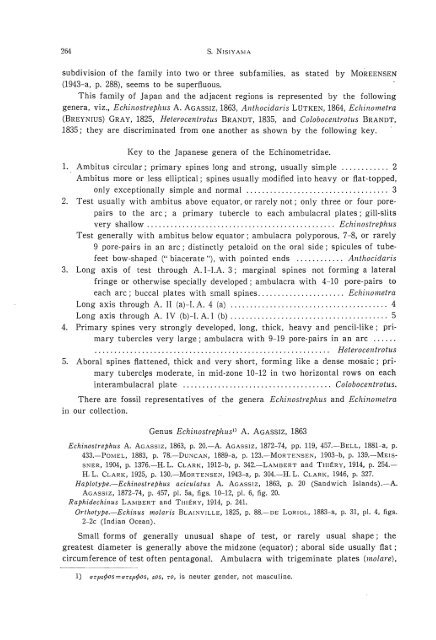the echinoid fauna from japan and adjacent regions part i
the echinoid fauna from japan and adjacent regions part i
the echinoid fauna from japan and adjacent regions part i
You also want an ePaper? Increase the reach of your titles
YUMPU automatically turns print PDFs into web optimized ePapers that Google loves.
264 S. NISIY Ai'vIA<br />
subdivision of <strong>the</strong> family into two or three subfamilies, as stated by MOREENSEN<br />
(1943-a, p. 288), seems to be superfluous.<br />
This family of Japan <strong>and</strong> <strong>the</strong> <strong>adjacent</strong> <strong>regions</strong> is represented by <strong>the</strong> following<br />
genera, viz., Echinostrephus A. AGASSIZ, 1863, Anthocidaris LUTKEN, 1864, Echinometra<br />
(BREYNIUS) GRAY, 1825, Heterocentrotus BRANDT, 1835, <strong>and</strong> Colobocentrotus BRANDT,<br />
1835; <strong>the</strong>y are discriminated <strong>from</strong> one ano<strong>the</strong>r as shown by <strong>the</strong> following key.<br />
Key to <strong>the</strong> Japanese genera of <strong>the</strong> Echinometridae.<br />
1. Ambitus circular; primary spines long <strong>and</strong> strong, usually simple ............ 2<br />
Ambitus more or less elliptical; spines usually modified into heavy or flat-topped,<br />
only exceptionally simple <strong>and</strong> normal .................................... 3<br />
2. Test usually with ambitus above equator, or rarely not; only three or four porepairs<br />
to <strong>the</strong> arc; a primary tubercle to each ambulacral plates; gill-slits<br />
very shallow ................................................ Echinostrephus<br />
Test generally with ambitus below equator; ambulacra polyporous, 7-8, or rarely<br />
9 pore-pairs in an arc; distinctly petaloid on <strong>the</strong> oral side; spicules of tubefeet<br />
bow-shaped (" biacerate "), with pointed ends ............ Anthocidaris<br />
3. Long axis of test through A. I-LA. 3; marginal spines not forming a lateral<br />
fringe or o<strong>the</strong>rwise specially developed; ambulacra with 4-10 pore-pairs to<br />
each arc; buccal plates with small spines ...................... Echinometra<br />
Long axis through A. II (a)-I. A. 4 (a) ........................................ 4<br />
Long axis through A. IV (b)-I. A. I (b) ........................................ 5<br />
4. Primary spines very strongly developed, long, thick, heavy <strong>and</strong> pencil-like; pri-<br />
. mary tubercles very large; ambulacra with 9-19 pore-pairs in an arc ..... .<br />
. . . . . . . . . . . . . . . . . . . . . . . . . . . . . . . . . . . . . . . . . . . . . . . . . . . . . . . . . . .. Heterocentrotus<br />
5. Aboral spines flattened, thick <strong>and</strong> very short, forming like a dense mosaic; primary<br />
tuberclts moderate, in mid-zone 10-12 in two horizontal rows on each<br />
interambulacral plate ...................................... Colobocentrotus.<br />
There are fossil representatives of <strong>the</strong> genera Echinostrephus <strong>and</strong> Echinometra<br />
in our collection.<br />
Genus Echinostrephusll A. AGASSIZ, 1863<br />
Echinostrephus A. AGASSIZ, 1863, p. 20.-A. AGASSIZ, 1872-74, pp. 119, 457.-BELL, 1881-a, p.<br />
433.-POMEL, 1883, p. 78.-DuNCAN, 1889-a, p. 123.-MoRTENsEN, 1903-b, p. 139.-MEIS<br />
SNER, 1904, p. 1376.-H. L. CLARK, 1912-b, p. 342.-LAi'vIBERT <strong>and</strong> THIERY, 1914, p. 254.<br />
H. L. CLARK, 1925, p. 130.-MoRTENsEN, 1943-a, p. 304.-H. L. CLARK, 1946, p. 327.<br />
Haplotype.-Echinostrephus aciculatus A. AGASSIZ, 1863, p. 20 (S<strong>and</strong>wich Isl<strong>and</strong>s).-A.<br />
AGASSIZ, 1872-74, p. 457, pI. 5a, figs. 10-12, pI. 6, fig. 20.<br />
Raphidechinus LAMBERT <strong>and</strong> THIERY, 1914, p. 241.<br />
Orthotype.-Echinus molaris BLAINVILLE, 1825, p. 88.-DE LORIOL, 1883-a, p. 31, pI. 4, figs.<br />
2-2c (Indian Ocean).<br />
Small forms of generally unusual shape of test, or rarely usual shape; <strong>the</strong><br />
greatest diameter is generally above <strong>the</strong> midzone (equator) ; aboral side usually flat;<br />
circumference of test often pentagonal. Ambulacra with trigeminate plates (molare),<br />
1) arpe90S = (J'rsprpos, cos, rO, is neuter gender, not masculine.












